
The Best Bank Branch Designs
Let’s face it: Bank branches over the decades have been slow to adapt to a changing retail environment. Walk in the closest corner branch today, and there is more likely to be a 30-year-old transaction-based queue—picture the teller line and velvet ropes—than a modern relationship-based experience. That is beginning to change. Some lenders have taken transformative steps to completely redefine how they meet customers in the retail environment. These trendsetters have first looked deep into their past to connect with their customers and their brand promise. Then, they’ve reconstructed a retail setting to best deliver that story in the 21st century.
Bank Director magazine spoke to leading design consultants, architects and retail strategy executives to find a sampling of innovators in the U.S. that displayed leadership in branch design.
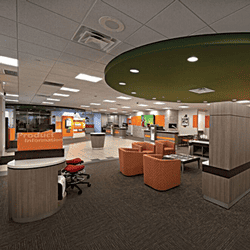
Countryside Bank
Countryside, Illinois
Countryside Bank, formerly known as State Bank of Countryside, over a 12-month period in 2014 and 2015 shortened its name, changed its branch operating model and redesigned all five of its branches and corporate headquarters outside of Chicago. It adopted the slogan, “It’s Grow Time,” to reflect its roots as a preferred lender for local homebuilders, while also expanding its focus to other commercial customers. For branch design, Countryside eliminated tellers and switched to universal bankers operating at free-standing pods who can conduct both transactions and relationship services. The bank put its products and services on full display on large video walls. Interactive tablets with details on services replaced paper brochures at check-writing stations. “Imagine walking into the Gap and not seeing any clothes on the racks,” says CEO John Wheeler. “You shouldn’t leave it to the customer to ask if they have any khakis. But that’s how a lot of banks act. We leave it on the customer to ask,” he says. A year into the investment, Countryside Bank opened more new retail accounts than any other time in its history.
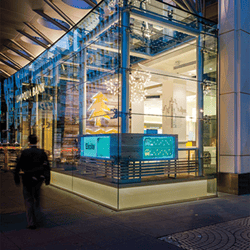
Umpqua Bank
Portland, Oregon
Everything about the design is intended to bring traffic and conversations into the store. Umpqua has its team spend hours in other popular shops and cafes nearby when it opens a neighborhood store to glean ideas. The lender uses lots of glass so passing traffic can see inside. It provides meeting rooms for small businesses to use for videoconferencing or board meetings. Bankers meet with clients at small tables with benches. The branches feel more like a community coffee house than a financial transaction center—Umpqua serves its own branded roast of coffee. The lender also puts its work on display. Huge wall art showcases how Umpqua serves its customers, and there are also snapshots of community history. A small marketplace section even sells goods from Umpqua’s local business customers.
Cost is always a question. But Umpqua’s Lani Hayward says because Umpqua redefined its branch operating model, it can build and operate its branches for the same price-per-square-foot as a traditional transaction-based bank branch. “It’s all about choosing where you spend your money,” she says.
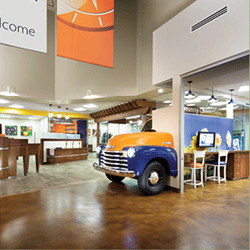
Rabobank
Roseville, California
Rabobank is laser-focused on the agricultural community. Over a 100-year history, this Dutch lender has met the needs of American farmers and ranchers. “Years ago, the banker went to the farm and sat down with the farmer at his kitchen table to talk about business, agriculture, his family,” says John Smith, president of consulting firm DBSI Inc., which designed the branch. “We wanted to bring those feelings back.”
In its new branches, Rabobank has made a large wooden kitchen table the focal point. Customers and bankers sit at the tables to discuss business and life. In larger branches, these tables are inside glass rooms with touchscreens embedded in the tabletop, designed to help bankers showcase how they can help clients. The new designs also include plenty of common technology elements—tablet computers, digital signs and video conferencing—while remaining true to the lender’s mission. “Everything is paperless and digital,” Smith says. “But they’re still serving farmers and ranchers around the proverbial kitchen table.”
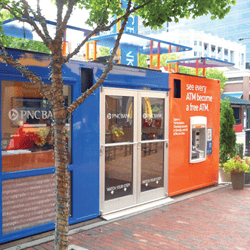
PNC BANK
Various locations
PNC Financial Services Group’s recent acquisitions and entrance into Southeast markets required a major push to raise brand awareness and win new accounts for its PNC Bank subsidiary. Years ago, an aggressive branch build would have been necessary. However, knowing that modern branch economics don’t support such an investment, PNC created pop-up branches, which are portable structures stationed for a few weeks or months in high traffic metro areas.
These 160-square-foot branches can be moved around and only conduct automated transactions. Staff are dedicated to advisory and sales, helping customers see how a relationship with PNC can help them. These consultants use tablets to demonstrate online and mobile services. For routine transactions, an ATM is available for customers to easily withdraw cash, including $1 bills, cash checks or deposit checks or cash.
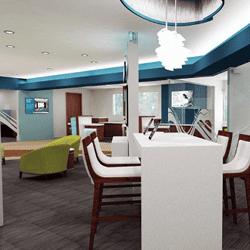
Seacoast Bank
Stuart, Florida
From the outside in, everything about Seacoast Bank’s newest branches align to its brand. The bank chose coastal locales, used bright teal and coastal blue colors and even lit up the buildings at night. Inside, Seacoast has replaced traditional banking with a modern, coastal retail vibe. There is immense digital signage everywhere, explaining products and Seacoast’s involvement in the community.
Large TV screens showcase local weather and beach conditions, catering to the tourism and coastal clientele. Following the lead of others, Seacoast has also eliminated teller lines. Instead, the lender relies on universal bankers to guide the loan application process and cross-sell other bank products and services. They use pods rather than traditional teller lines. Even though there’s rarely any waiting in line, the bank still makes sure to offer excess lounge space with interactive touchscreens, tablet computers and refreshments.

